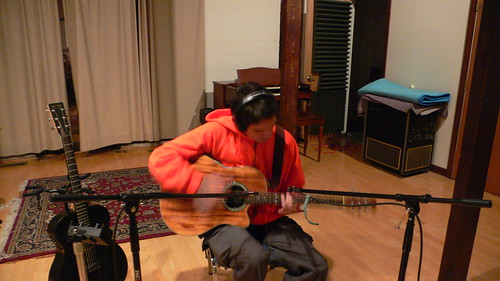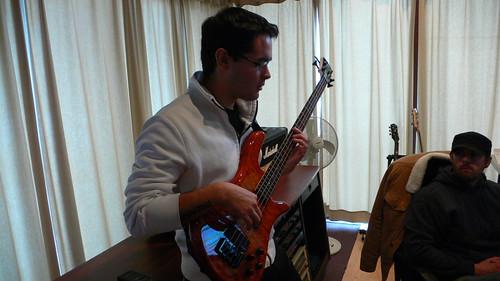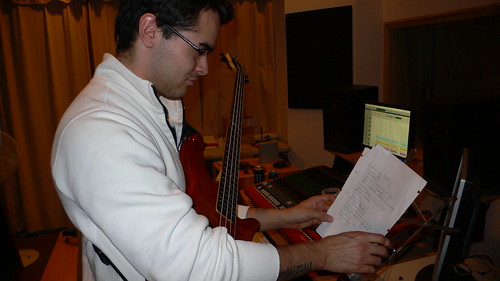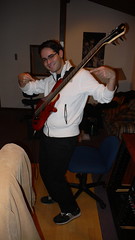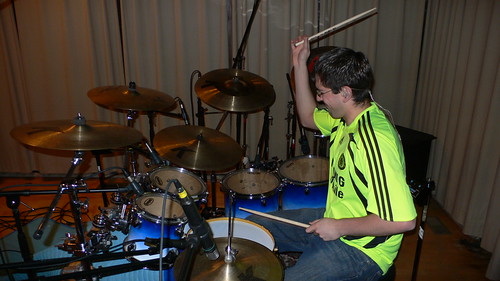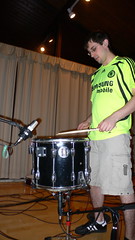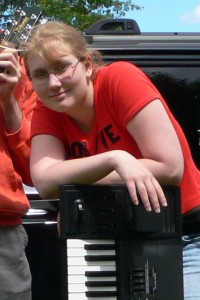 The lovely and talented Karen Rustad has been with working closely with Wrong Side of Dawn since its formation. Karen was there at our first rehearsals, with just me and Brian before we had any other musicians to work with. Karen has repeatedly lent us her artistic skills, doing an amazing job on the cover art for our old EP and the Grinder’s Tale 3P, and she’s currently working on a draft of the cover art for the upcoming Stay Awake album. She also did all of the graphic design and most of the web design for our beautiful website. [Incidentally, she’s currently looking for work. Maybe you could help her out? 😉 ]
The lovely and talented Karen Rustad has been with working closely with Wrong Side of Dawn since its formation. Karen was there at our first rehearsals, with just me and Brian before we had any other musicians to work with. Karen has repeatedly lent us her artistic skills, doing an amazing job on the cover art for our old EP and the Grinder’s Tale 3P, and she’s currently working on a draft of the cover art for the upcoming Stay Awake album. She also did all of the graphic design and most of the web design for our beautiful website. [Incidentally, she’s currently looking for work. Maybe you could help her out? 😉 ]
In addition, Karen is a serious singer and songwriter in her own right, having sung in choirs for many years, contributed her voice to musical groups such as Tryad (you can hear her singing lead vocals on “Beauty” from their album Listen) and written and recorded several wonderful tracks on her home computer. We had good experiences with her contributing vocals and some keyboards to our previous album attempt, so it is no surprise that we brought in Karen again to help us compose and sing the backing vocals on the “Stay Awake” album.
Adapting live vocal harmonies for a studio album
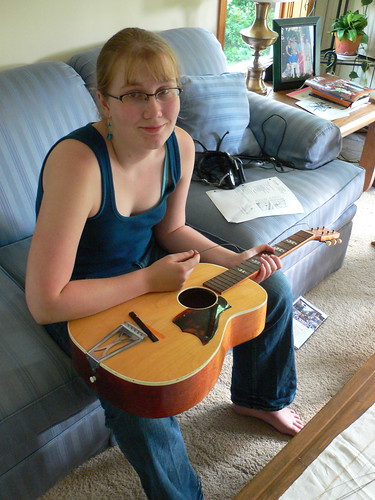 Karen has been performing at open mikes etc. with me since before WSD took its first steps towards recording a studio album. One song that she sang with me was Break Free (which is an ancient song that I originally wrote when I was in high school), and she wrote her own vocal harmony part to accompany me. On our previous attempt at recording this album, Karen simply sang the exact same vocal harmony that she sang when performing as a duo with me. However, this didn’t work quite as well with a full band, because Karen sang what amounted to a vocal solo during the bridge, at the same time as Brian’s guitar solo. Having two “solos” going at once made the song sound a little busy and disorganized, although there were a few nice interactions between Karen’s singing and Brian’s lead guitar.
Karen has been performing at open mikes etc. with me since before WSD took its first steps towards recording a studio album. One song that she sang with me was Break Free (which is an ancient song that I originally wrote when I was in high school), and she wrote her own vocal harmony part to accompany me. On our previous attempt at recording this album, Karen simply sang the exact same vocal harmony that she sang when performing as a duo with me. However, this didn’t work quite as well with a full band, because Karen sang what amounted to a vocal solo during the bridge, at the same time as Brian’s guitar solo. Having two “solos” going at once made the song sound a little busy and disorganized, although there were a few nice interactions between Karen’s singing and Brian’s lead guitar.
When we started recording Break Free again at Portrait Studios for “Stay Awake,” I asked Karen to try writing some new harmonies that would be more choral and less busy-sounding, to avoid the problem of it sounding like there were two solos at once. Karen obliged by singing two-part harmonies, using them to create chords rather than an entirely independent melody line. I think the resulting backing vocals step back during the main part of Brian’s guitar solo in the bridge and give him more space, but also sound more impressive in a Cranberries-esque fashion. Naturally this is impossible for Karen to sing live without help, but that’s what’s great about studio albums, they free you from limits such as how many people you can put on stage at once.
Auto-Tune
Another issue that we had to confront frequently when recording with Karen and mixing her parts was when and if to use Auto-Tune. This is not because Karen has bad pitch, she’s probably on key more often than I am. This is because almost all of her vocal parts are harmony parts. Brian and I could get away with being a little loose with pitch when singing by ourselves, but whenever we bust out the vocal harmonies, any sourness in pitch is immediately and painfully obvious. Although some of Karen’s parts came out fine, we ended up having to use Auto-Tune extensively in some passages. One passage in “Out of Time” couldn’t even be saved by Auto-Tune (which says bad things about my ear because it sure sounded in tune to me when she recorded it) and we ended up having to throw out her part in that section. Whenever we discovered that Brian or myself were irreparably out of tune during mixing, we could re-take that section on the spot, but Karen wasn’t around during the mixing process, so it was a case of Auto-Tune or die. If someone is doing a difficult vocal harmony (or something similar) and you can’t get them in the studio again easily to fix any problems, I recommend that you record multiple takes and save them all, just in case there are undiscovered problems with the take that you thought was perfect.
For the record, Brian and I would have preferred to not use Auto-Tune at all on this album. We generally went for a straightforward “live” sound on this album, we didn’t want to sound too heavily processed and suspiciously clean. However, there is a trade-off between the time necessary to re-record a passage and the time required to Auto-Tune it. If you’re perfectionist enough to go and fix every little note by re-recording it, you’ll be spending a lot of time in the studio, and a lot of dough (unless you own the studio). Besides, if you have to do a zillion re-takes for each section to get it right, how much more genuine is that than Auto-Tune? Aren’t you using machines to cover up your shortcomings as a musician either way? The best, most “genuine” and impressive way to avoid Auto-Tune would be to practice until your vocal cords bleed, and then sing the song perfectly, without requiring any re-takes or Auto-Tune. Sadly, we just aren’t that good yet, and reality forced our hand.
Surprise harmonies
The vocal harmonies in the chorus of The Grinder’s Tale (listen around 2:55-3:15) came as something of a surprise to all of us. In one of the last recording sessions, we entered the studio with the vague mission of “add more vocal harmonies to the album” because Mr. Gutkowski (my old Latin teacher and indie rock mentor) had said something about how great vocal harmonies separate the pros from the amateurs, and we had agreed with him wholeheartedly. Brian came up with ideas for a couple harmony parts in his car while driving to the studio, singing along to the rough mixes. Karen had a different idea, however, and that sounded good too. So we figured, why not put all of those harmony parts on the record? Karen went off into another room in the studio alone with my iPod with the broken earbuds singing and re-singing the harmony parts until they gelled, and then we recorded the 4-part harmony together.
Similarly, the harmony during the “oohs” on Last Warning was a last-minute addition (listen around 2:44-3:04). I said something like “Hey Karen, Brian sounds kind of lonely in that part, why don’t you go help him out and add a harmony part?” The toughest part was the last note of the harmony. Karen tried a couple different notes, but nothing sounded right except that 2nd we have on the record. Karen was like, “You really want it to end on that dissonant note?” And we were like, “Yep.” The suspension resolves, sort of, when the rest of the band comes in, but dissonant or not we love it to death.
Karen’s interview
N: Karen Rustad, you’ve just finished recording all of your vocals for the Stay Awake album. How does it feel?
Karen: Uhhhhhheehhhhhhhhh [Karen fakes dying]
N: Speak words, woman.
Karen: 😛 Nah, it’s good. I’m glad we got it done in time – barely. I’m happy with the new harmonies we were able to add on, maybe. We’ll see… It’s something different!
N: Alright. And what was your favorite song to record?
Karen: Probably Contained. It was easy. And, sounds good as ever.
N: OK, least favorite?
Karen: Break Free took too long! Ohmigod! I think it’ll sound really cool, but it took *forever*, and I had problems with pitch, until I realized that it’s a lot easier if you only cover one ear.
N: Interesting. So just having one ear outside the headphones…
Karen: Yeah, even though you have a monitor feeding it back to you, for some reason it’s a lot easier if I hear my voice for real, rather than it being broadcast back. A lot easier for me to adjust.
N: OK! And how do you think the album is coming?
Karen: I think it’s coming really good! This is wayyy better-sounding than the previous attempt. And I expect it’s going to be really playable and I hope that it gets lots of interwebs attention 😀
N: Alright, well, thank you 🙂

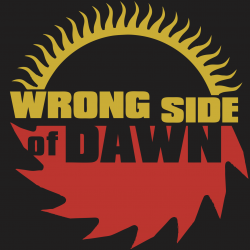


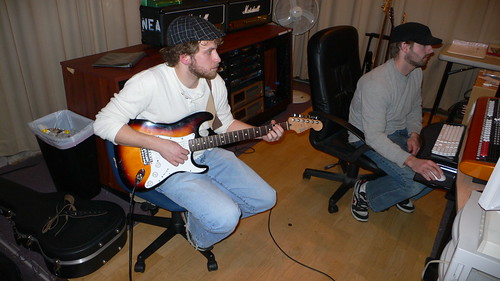
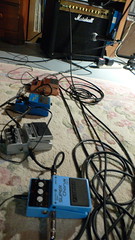
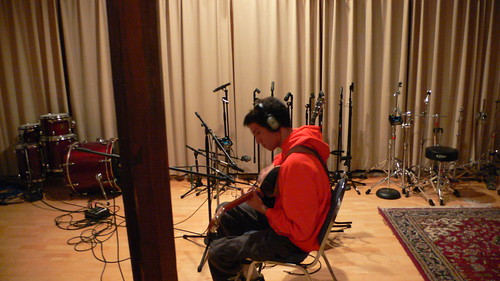
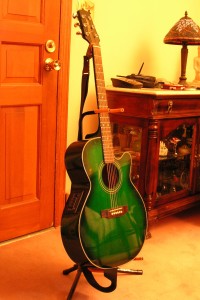 I am in love with my green Takamine acoustic-electric, named “Kermit”, and I would generally want to use it in any situation. However, recently Kermit has started going out of tune if I play high on the fretboard, and unfortunately many of our songs require me to do that. I didn’t have a chance to get Kermit’s problems checked out at the guitar store before recording started, so I had to use other guitars that were more in tune.
I am in love with my green Takamine acoustic-electric, named “Kermit”, and I would generally want to use it in any situation. However, recently Kermit has started going out of tune if I play high on the fretboard, and unfortunately many of our songs require me to do that. I didn’t have a chance to get Kermit’s problems checked out at the guitar store before recording started, so I had to use other guitars that were more in tune.